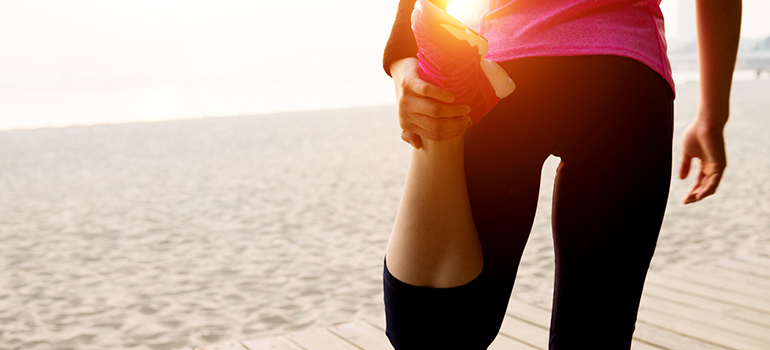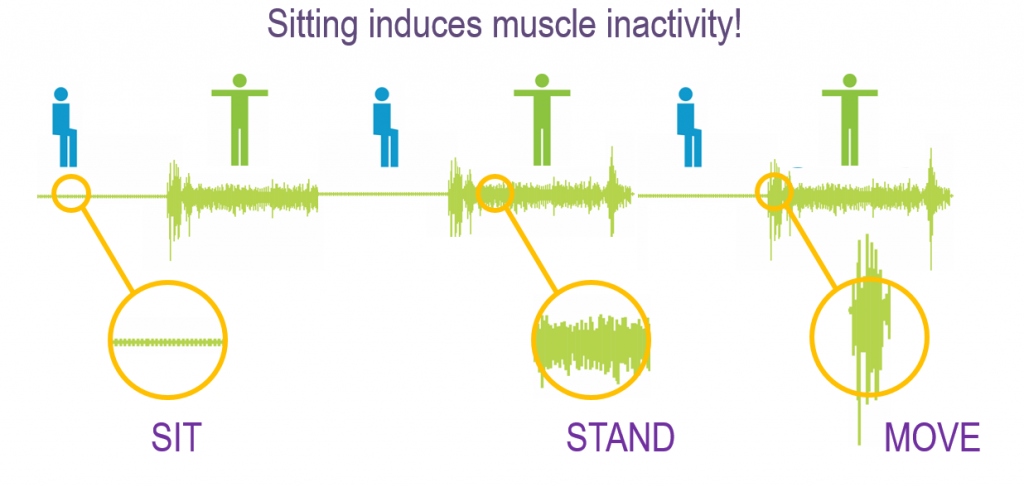
MoveMore Blog
The latest in workplace wellness

The Deep-Seated Science Behind Lower-Body Movement
Most computer workers have heard warnings about how sitting is the new smoking and how breaking up sitting time with a sit-stand desk has many health benefits. I support this active workstyle based on my own experience using a sit-stand desk for the last 10 years and because of evidence-based, scientific data. But I’ve always wondered if interrupting sitting with low-level movement throughout the day is the remedy for sedentary time, wouldn’t it be enough for us to wave our arms around periodically? Why do we have to get out of our chairs every 30 minutes and stand?
At the National Ergonomics Conference and ErgoExpo last August, I had a chance to discuss this topic with Joan Vernikos, author of “Sitting Kills, Moving Heals: How Everyday Movement Will Prevent Pain, Illness, and Early Death – and Exercise Alone Won’t.”
As a former NASA scientist, Dr. Vernikos and her colleagues learned that there are similarities between zero gravity and aging. They observed that people in space, like people who are sedentary, age more quickly. I asked Dr. Vernikos if there was a unique health impact related to moving the lower part of the body that couldn’t be accomplished by moving the upper half of the body alone. Her answer? A resounding, “yes!”
Since that conversation, I have discovered similar insights in sedentary behavior studies. In a study of London transportation workers published by Morris et al (1953), researchers in Great Britain documented a higher risk of cardiovascular disease among bus drivers who sat behind the wheel versus those conductors who stood, walked the aisles, and climbed stairs while punching tickets. What was the difference between the driver and a conductor’s behavior? One sat with the legs from hip to knee parallel to the floor while the corresponding limbs of the conductor were vertical and often in motion.
This is how Dr. Vernikos describes the difference: “When we stand up, gravity is experienced in the head-to-toe direction (Gz); less Gz is felt during sitting because the body’s vertical column aligned with gravity is shorter and supported.”
She goes on to say, “Movement in the presence of gravity imposes a physical stress that results in increased energy exchange, evidenced by a dramatic increase in oxygen uptake, respiration, heart rate, stroke volume, cardiac output and sweating.”
What happens when we don’t challenge gravity by being upright and moving? Dr. Marc Hamilton explored the importance of lower body activity by studying inactive muscle physiology in the hind limbs of rats. Through his work, he found that: “Experimentally reducing normal spontaneous standing and ambulatory time had a much greater effect on LPL regulation than adding vigorous exercise training on top of the normal level of nonexercise activity.”
A comparison of the different levels of postural muscle activation is illustrated below. You’ll see that the largest jump in nerve signaling occurs when moving from sitting to standing.

Here’s the key finding: the postural muscles of our legs, buttocks and lower back have special qualities that smaller muscle groups, like our arms, do not. These “slow twitch” muscles are designed for endurance. They are packed with mitochondria for energy conversion and myoglobin to carry oxygen to muscle fibers for quick bursts of movement.
At a molecular level, postural muscles send powerful signals about the need to produce more energy, creating a crucial relationship between low intensity physical activity and our metabolism, endocrine system, and even mood and mental functions. If these muscles are not regularly engaged, numerous systems begin to slow down with catastrophic long-term consequences starting as early as age 20. Obesity, Type 2 diabetes, fatty liver, hardened arteries and high blood pressure are just a few markers related to reduced movement in the lower body.
If slow-twitch muscles are not activated over time, they lose the high ratio of mitochondria myoglobin that differentiate them from fast-twitch muscles until they become fast-twitch muscles. You can see the difference in the visualization below:

Most daily activities use slow twitch muscles. Dr. James Levine describes these activities as NEAT (non-exercise activity thermogenesis). We now know that exercise alone is not enough to keep us healthy. Non-exercise physical, NEAT activity is just as important. Most of your day should be spent doing low-intensity, non-exercise physical activity, in addition to at least 150 minutes of moderate to vigorous physical activity. Unfortunately, in our highly digital, mechanized world, NEAT has largely been replaced with time and labor saving devices like lawn mowers, washing machines, cars and fast food. Even our leisure time movement has been undercut: watching a ball game, online shopping, movies and TV are all spent sitting.
We are bombarded daily with messages about our health. From fitness apps to food choices, we are directed to a myriad of ways to claim the one thing that seems to grow more elusive every day. Finding time to eat right, exercise and do all that is needed to become and stay healthy sometimes feels like a full-time job itself. No wonder we seek ways to save time, but at what cost?
Through their investigations, Dr. Vernikos, Dr. Hamilton, Dr. Levine and the others like them are revealing ways we can all start working toward our health in a smarter way. What’s the bottom line when it comes to using a sit-stand desk? First, muscles, like levels of physical activity, are not the same. Our bodies are smart like that. Keep up your exercise routine, but don’t underestimate the need for plenty of low-level activity. Use the muscle groups in your lower part of your body to your advantage. Stand more often. Use tools, like a sit-stand desk, to activate the sedentary parts of your day. You may not see this knowledge on the next ad for a Fitbit, but it will help you appreciate your Fitbit results a little more.
I don’t want to give the impression that the science behind sit-stand desks is simple. In fact, the more research that is published, the more scientists call for further research. We still have much to learn, but what we do know is that movement matters and not just dedicated time at the gym. Our hope is that through sharing this type of science through JustStand.org, you will begin to make up your own mind about how to achieve better health with regular activity, whether at work, home or in the classroom.
Relevant Posts
Stay in the know
Sign up and get the latest and greatest content from JustStand's MoveMore blog.